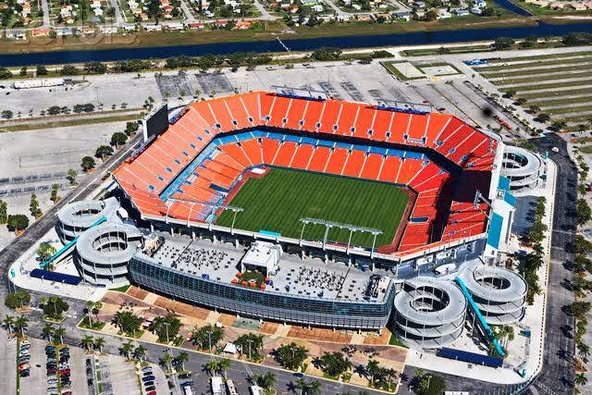In a monumental move that is shaking the foundation of college football, the University of Miami Hurricanes have announced a jaw-dropping, $5.3 billion renovation project for Hard Rock Stadium—one that will completely redefine what it means to experience the sport at the collegiate level. With the unveiling of renderings and design plans this week, the Hurricanes have set a new gold standard, creating a futuristic and lavish environment that blends cutting-edge technology, luxurious amenities, and expanded capacity into a spectacle never before seen in NCAA athletics.
This investment doesn’t just speak to the ambition of the Hurricanes—it marks a pivotal moment for the future of college football and stadium infrastructure as a whole.
A New Era for ‘The U’: Ambition Meets Innovation
Hard Rock Stadium, which has served as the home of the Miami Hurricanes since 2008, was already a major venue in American sports, hosting Super Bowls, international soccer matches, concerts, and the Miami Open tennis tournament. However, this $5.3 billion overhaul catapults the venue into an entirely new realm—one that rivals the best arenas in the world, both college and professional.
“This isn’t just about football,” said University of Miami Athletic Director Dan Radakovich. “This is about transforming the Miami gameday experience into something truly unforgettable—about leading college football into a future driven by fan engagement, high-tech immersion, and unmatched comfort.”
The renovations are scheduled to roll out in phases, with full completion expected before the 2028 college football season. However, Hurricanes fans can expect several major upgrades to be unveiled as early as 2026.
Architectural Marvel: Bigger, Bolder, Better
The new-look Hard Rock Stadium is an architectural wonder. Designed by the internationally acclaimed firm Populous—the same masterminds behind Tottenham Hotspur Stadium and SoFi Stadium—the design blends Miami’s iconic Art Deco style with futuristic elegance.
Among the most striking changes:
- Seating expansion from 65,000 to 80,000, with improved sightlines and acoustics.
- A retractable roof for weatherproof comfort and enhanced acoustics.
- 360-degree LED halo scoreboard that wraps around the upper bowl, offering fans immersive video content from every angle.
- Glass-clad exterior with LED-lit fins that allow the stadium to change colors, creating a vibrant skyline presence in the heart of Miami Gardens.
These changes are not just aesthetic—they’re aimed at giving the Hurricanes a true home-field advantage, with crowd noise expected to reach NFL levels of intensity.
Tech Heaven: Augmented Reality, AI, and Seamless Connectivity
What truly sets this renovation apart is the level of technology being implemented. Hard Rock Stadium will become the first “smart stadium” in college football—an ultra-connected environment powered by AI, 5G, and augmented reality (AR) systems.
Some of the marquee features include:
- Augmented Reality Game Stats: Fans using AR glasses or their smartphones can overlay live stats, player bios, and real-time replays over the field while watching the action.
- AI-Powered Traffic and Parking Systems: Integrated systems will guide fans to their assigned lots using real-time traffic data, reducing congestion and entry times.
- Dynamic Concessions: With Amazon’s “Just Walk Out” technology, fans can grab food and drinks without standing in lines or using a checkout counter.
- Hyper-personalized Experiences: AI-driven apps will offer fans custom in-stadium suggestions for food, merch, and entertainment based on preferences and location.
Every seat in the stadium will have access to high-speed Wi-Fi 7, allowing fans to live-stream, share content, and engage socially at blazing-fast speeds.
Luxury Like Never Before: 100+ Suites, Sky Villas, and Field-Level Clubs
One of the renovation’s most buzzworthy components is the introduction of luxury spaces that rival those found in world-class resorts.
- “Sky Villas”: High above the stadium bowl, these 25 opulent suites feature private balconies, personal chefs, concierge services, and panoramic views of both the field and the Miami skyline.
- Field-Level Clubs: Just feet from the sidelines, these exclusive lounges offer gourmet dining, cocktail bars, and leather recliners—turning game day into a five-star social event.
- The 305 Club: Named for Miami’s iconic area code, this members-only experience will include rooftop access, celebrity DJs, art galleries, and signature South Florida cuisine.
- Luxury Loge Boxes and Executive Suites: With more than 100 new configurations for corporate entertaining and private groups, every type of fan—whether casual or elite—will find a home in the revamped stadium.
Fan Comfort First: Climate, Commute, and Convenience
Understanding that Miami’s climate can be both a blessing and a curse, the new stadium design is hyper-focused on comfort and sustainability.
The retractable roof allows for natural light and breeze while providing protection from rain and heat. Additionally, every section will feature climate-controlled ventilation, ensuring fans can enjoy the game without baking in the sun or drowning in humidity.
New transit options include:
- A light rail connection to Miami International Airport and downtown.
- Enhanced Uber/Lyft zones for smoother pick-up and drop-off.
- Electric vehicle charging stations and green parking options throughout the lot.
Sustainability is a key part of the project. The stadium is set to become the first net-zero carbon college football venue, with solar panels, water recycling systems, and composting initiatives all incorporated into its core design.
Recruiting Advantage: The Best Facilities in the NCAA
While fan experience is a major component of the renovation, competitive edge is also top of mind. The Hurricanes are poised to use this new stadium as a game-changer in recruiting.
The stadium will include:
- A state-of-the-art player tunnel and locker room complex equipped with biometric tracking, recovery suites, and performance labs.
- Custom-designed recruiting lounges with interactive screens showcasing Miami’s storied football history.
- A digital innovation lab, where players and coaches can break down film using VR and AI-assisted play simulations.
“It’s no longer enough to show recruits good facilities—you have to show them the future,” head coach Mario Cristobal said. “This stadium, and everything it comes with, screams future.”
Economic Boom and Cultural Impact
The project is not only expected to boost the Hurricanes’ prestige, but also spark an economic boom in the region. With over 30,000 new jobs projected during construction and thousands more in permanent roles afterward, the stadium’s impact stretches far beyond football.
Local businesses and tourism will benefit, and the area around the stadium will be transformed into a mixed-use district with:
- Restaurants
- Boutiques
- Sports bars
- Live music venues
- A university-themed hotel
City officials praised the project, calling it a “once-in-a-generation opportunity” to reposition Miami Gardens as a major cultural hub.
A Bold Challenge to the SEC and Big Ten
With the college football landscape changing rapidly due to NIL, superconferences, and expanded playoff structures, Miami’s $5.3 billion renovation sends a clear message: The Hurricanes are here to compete at the highest level—on and off the field.
While SEC powers like Alabama and Georgia have invested heavily in facilities, and Big Ten giants like Ohio State boast massive stadiums, no program has delivered a single-venue package with the ambition or scope of what Miami is now building.
College football analysts have already begun speculating how this transformation could catapult the Hurricanes back into perennial playoff contention.
“This isn’t just a renovation—it’s a revolution,” said ESPN’s Kirk Herbstreit. “It challenges the entire college football establishment.”
Looking Ahead: The Road to 2028
The first phase of renovations will focus on upper-deck expansions, AI system installation, and concession modernization. Major construction will pause during football seasons to avoid displacing the team or fans, but smaller enhancements will be visible by the 2026 kickoff.
University officials promise transparency and regular updates throughout the process. A dedicated fan engagement app will allow season ticket holders to track progress and preview what’s coming next.



